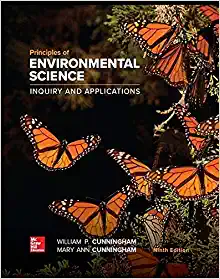Description
Principles of Environmental Science 9Th edition By William – Test Bank
Principles of Environmental Science, 9e (Cunningham)
Chapter 3 Evolution, Species Interactions, and Biological Communities
1) ________ habitat specialist found exclusively in one specific type of habitat.
A) Keystone species
B) Endemic species
C) Pioneer species
D) Niche species
E) Mutualistic species
Answer: B
Section: 03.01
Topic: Natural Selection
Bloom’s: 2. Understand
Chapter: 03
Accessibility: Keyboard Navigation
2) Individual species will continually evolve as a result of ________, with certain genetic combinations becoming more predominant.
A) coevolution
B) convergent evolution
C) punctuated equilibrium
D) natural selection
E) gradualism
Answer: D
Section: 03.01
Topic: Natural Selection
Bloom’s: 2. Understand
Chapter: 03
Accessibility: Keyboard Navigation
3) Which of the following does not contribute to limits on population growth?
A) snakes feeding on mice in a cornfield
B) bears having two cubs
C) the amount of light for photosynthesis
D) a disease-causing organism entering a population
E) an increase in the total rainfall in a normally dry environment
Answer: E
Section: 03.03
Topic: Natural Selection
Bloom’s: 3. Apply
Chapter: 03
Accessibility: Keyboard Navigation
4) ________ is the development of a new species.
A) Adaption
B) Speciation
C) Ecotone
D) Evolution
E) Mutation
Answer: B
Section: 03.01
Topic: Speciation
Bloom’s: 2. Understand
Chapter: 03
Accessibility: Keyboard Navigation
5) Which of the following is a common strategy for successful intraspecific competition?
A) eating prey before they are “ready” (ripe) for other species
B) spreading seeds or offspring far and fast
C) producing substances that are toxic to competitors
Answer: B
Section: 03.01
Topic: Tolerance Limits
Bloom’s: 1. Remember
Chapter: 03
Accessibility: Keyboard Navigation
6) There is/are usually ________ tolerance limit(s) responsible for limiting the number and location of a species. However, some organisms have ________ that limit(s) their distribution.
A) one; a specific critical factor
B) one; other environmental conditions
C) one specific; many factors
D) many; other environmental conditions
E) many; a specific critical factor
Answer: E
Section: 03.01
Topic: Tolerance Limits
Bloom’s: 3. Apply
Chapter: 03
Accessibility: Keyboard Navigation
Use the following example for the question. A species of fish can withstand a narrow range of temperature. Above 100°F there are no individuals present. In the range from 97°F—100°F and 90°F—94°F there are a few individuals present. Below 90°F there are no individuals present. Between 95°F—96°F there are many individuals.

Reviews
There are no reviews yet.